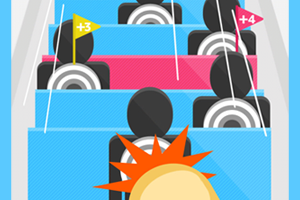このアプリのYoutube動画がある場合はURLを送信してください。詳細 »
APPLICATION INFO - iPhoneアプリの詳細情報
![]()
With its 2010 release, "Radiology 2.0: One Night in the ED" became the first radiology teaching file to simulate reading scans at a PACS workstation. The fifth instalment has now arrived: MRI Soft Tissue Contrast: Tissue Property Filters.
Magnetic Resonance Imaging, or MRI, is a commonly used imaging modality in modern medicine yet the basics behind how this technology works is often poorly understood by the radiologists interpreting the images. Why are some tissues brighter than others? Why do tumours, traumatic injuries, or areas of inflammation look different from normal tissue? How does the way the images are acquired affect how normal and abnormal tissues look?
The traditional way of explaining tissue contrast on MRI is to create plots of tissue signal versus time based on the Bloch Equations. This explains what is happening to protons in a specific tissue in the MRI scanner, but does not explain why tissues or pathology are bright are dark relative to each other. Nor does it explain how to obtain images optimised to detect subtle pathology in specific tissues.
The concept of tissue property filters recasts the Bloch equations as plots of signal versus tissue specific properties such as T1, T2, proton density, mean diffusivity, etc . . . This allows one to see how, for a given pulse sequence, the specific characteristics of a tissue results in it being either bright or dark on an image. A simple mathematical model of "image weighting" is made by looking at the slope of these plots. By interacting with these graphs understands how to set sequence parameters such as TR, TE, TI, and flip angle to optimise contrast between normal and abnormal tissues, i.e. how to make images sensitive to disease.
This intuitive teaching file is designed for practicing radiologists who want to better understand how MRI works. By interacting with plots of the Bloch equations the user will learn what "weighting" actually means. The app explains why common tissues (white matter, grey matter, fluid, muscle, fat, and ligaments) look the way they do on traditional PD, T1, and T2 images and how sequence parameters are optimised to accentuate differences between tissues. It also explains how inversion recovery increases "T1 weighting," and why sequences like FLAIR and STIR are both advantageous and limited.
The extensive content is contained within the app for offline viewing. You can learn radiology on-the-go and in the palm of your hand, even with a few minutes of spare time throughout the day. It is completely free and provided as a resource for medical education. No in app purchases. No subscription fees.
Additional:
- Dr. Daniel Cornfeld is a consultant radiologist at Matai Medical Research Imaging and Te Whatu Ora Tairawhiti, both in Gisborne, New Zealand. Prior to that he was an Associate Professor of Diagnostic Radiology at Yale University School of Medicine. The underlying physical principles discussed in this app were developed by Graeme Bydder and Ian Young.
Magnetic Resonance Imaging, or MRI, is a commonly used imaging modality in modern medicine yet the basics behind how this technology works is often poorly understood by the radiologists interpreting the images. Why are some tissues brighter than others? Why do tumours, traumatic injuries, or areas of inflammation look different from normal tissue? How does the way the images are acquired affect how normal and abnormal tissues look?
The traditional way of explaining tissue contrast on MRI is to create plots of tissue signal versus time based on the Bloch Equations. This explains what is happening to protons in a specific tissue in the MRI scanner, but does not explain why tissues or pathology are bright are dark relative to each other. Nor does it explain how to obtain images optimised to detect subtle pathology in specific tissues.
The concept of tissue property filters recasts the Bloch equations as plots of signal versus tissue specific properties such as T1, T2, proton density, mean diffusivity, etc . . . This allows one to see how, for a given pulse sequence, the specific characteristics of a tissue results in it being either bright or dark on an image. A simple mathematical model of "image weighting" is made by looking at the slope of these plots. By interacting with these graphs understands how to set sequence parameters such as TR, TE, TI, and flip angle to optimise contrast between normal and abnormal tissues, i.e. how to make images sensitive to disease.
This intuitive teaching file is designed for practicing radiologists who want to better understand how MRI works. By interacting with plots of the Bloch equations the user will learn what "weighting" actually means. The app explains why common tissues (white matter, grey matter, fluid, muscle, fat, and ligaments) look the way they do on traditional PD, T1, and T2 images and how sequence parameters are optimised to accentuate differences between tissues. It also explains how inversion recovery increases "T1 weighting," and why sequences like FLAIR and STIR are both advantageous and limited.
The extensive content is contained within the app for offline viewing. You can learn radiology on-the-go and in the palm of your hand, even with a few minutes of spare time throughout the day. It is completely free and provided as a resource for medical education. No in app purchases. No subscription fees.
Additional:
- Dr. Daniel Cornfeld is a consultant radiologist at Matai Medical Research Imaging and Te Whatu Ora Tairawhiti, both in Gisborne, New Zealand. Prior to that he was an Associate Professor of Diagnostic Radiology at Yale University School of Medicine. The underlying physical principles discussed in this app were developed by Graeme Bydder and Ian Young.
※iPadでご利用できるアプリです。
カテゴリー
教育
教育
リリース
2024/4/29
2024/4/29
バージョン
1.0
1.0
言語
サイズ
13.9 MB
13.9 MB
条件
Daniel Cornfeld の他のアプリ » もっと見る
» 目的別iPhoneアプリ検索
- 辞書 » 日本語対応の辞書 » 英和辞典
- 学習 » 英単語 » 英会話 » クイズで楽しく
- スケジュール » 管理 » Googleカレンダー





めちゃギントン めちゃイケメンバーと擬音で遊ぼう
FujiTV無料

本気で英会話!ペラペラ英語 英単語・リスニング・TOEICの..
SpeakBUDDY Ltd.800 円

「おやこでリズムえほんDX」 赤ちゃん・幼児・子ども向けの音..
SMARTEDUCATION, Ltd.無料

星座表
ESCAPE VELOCITY LIMITED無料

続く英語学習 えいぽんたん! 英単語からリスニングまで
Drecom Co., Ltd.無料

絶対話せる!英会話
Yuko Kubota無料

英単語アプリ mikan
mikan Co.,Ltd.無料

毎日英語 音声で英語を学習して単語を管理できるアプリ
OKPanda KK無料

Studyplus - 勉強管理SNS
Studyplus Inc.無料

みんなの英単語
Jooying Tech Co.,Ltd.無料
CatchApp新着アプリレビュー

様々な楽しみ方で運転士として成長していく鉄道運転士育成RPG「プラチナ・トレイン(プラトレ) 日本縦断てつどうの旅」
2016-05-17 00:00

日本語にはない英語発音のリスニングを楽しく学べる「発音どっち?英語リスニング 」
2014-12-20 12:00

指先の瞬発力が試されるカジュアルゲーム「早撃ちパニック」をリリース!
2014-12-08 15:21
新着アプリ動画








